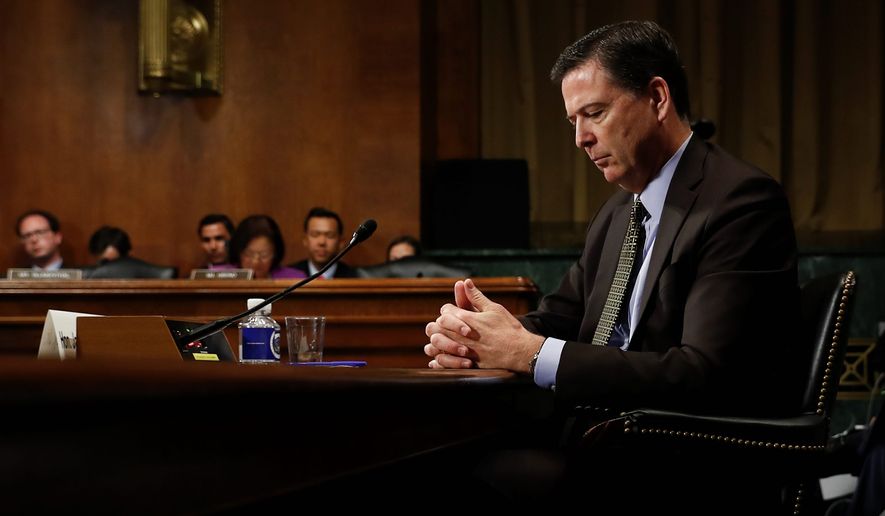Former FBI Director James B. Comey’s motives for briefing President-elect Trump on the Democratic Party-financed dossier included that Mr. Trump might offer up evidence that would help the bureau’s probe into the Republican’s campaign and Russia, a Justice Department report says.
After his now-infamous meeting with the president-elect at Trump Tower on Jan. 6, 2017, Mr. Comey immediately briefed the probe’s supervisors in Washington on a secure video conference. Those briefed would have included FBI agent Peter Strzok, who started and headed the operation and vowed to “stop” Mr. Trump in private texts.
The public narrative for the one-on-one is that Mr. Comey wanted to alert Mr. Trump on the dossier’s allegation that he engaged with prostitutes in Moscow in 2013. Mr. Comey had learned through his press office that CNN was preparing to report on the dossier. The public later learned that the discredited scandal sheet was written by British ex-spy Christopher Steele, who was paid by the Democratic Party and the Hillary Clinton campaign.
But the FBI’s decision to confront Mr. Trump with the dossier had a far more serious motive, according to Justice Department Inspector General Michael E. Horowitz in his 83-page report released last week.
The run-up went this way:
Since July 31, 2016, and perhaps before that, the FBI was investigating whether the Trump campaign conspired with the Kremlin to interfere in the 2016 election by computer hacking and social media information warfare.
Mr. Comey’s inner circle saw his meeting with Mr. Trump as a chance to gain information from the candidate himself for “Crossfire Hurricane,” as the probe was code-named.
Mr. Comey’s closest aides — Deputy Director Andrew McCabe, General Counsel James Baker, Chief of Staff James Rybicki and those supervising “Crossfire Hurricane,” which would seem to include Mr. Strzok — huddled to set strategy.
“Witnesses interviewed by the OIG [Office of the Inspector General] also said that they discussed Trump’s potential responses to being told about the ’salacious’ information, including that Trump might make statements about, or provide information of value to, the pending Russian interference investigation,” Mr. Horowitz wrote.
Mr. Comey subsequently memorialized the meeting in what the IG report dubbed “Memo 1.”
Mr. McCabe, who was fired by the FBI for allegedly lying to investigators for a previous IG report, urged the creation of Memo 1 because Mr. Trump might misrepresent what happened.
Immediately after the Trump meeting, Mr. Comey began writing Memo 1. At the FBI’s New York field office, he gave his aides and the Crossfire Hurricane team a briefing on what Mr. Trump had said.
The IG report said Mr. Comey classified his Memo 1 as “secret.” The report doesn’t say what specifically he told his team. Mr. Trump fired Mr. Comey in May 2017.
In his memoir “A Higher Loyalty,” Mr. Comey does not say that he was hunting for Crossfire Hurricane evidence when he gave Mr. Trump a five-minute dossier briefing. He also didn’t disclose that he briefed the Crossfire team minutes later when he arrived at the FBI field office.
The Trump meeting’s main purpose was to tell the president-elect about the intelligence community’s findings on Russian election interference. Director of National Intelligence James Clapper, a Barack Obama appointee, had urged Mr. Comey to meet privately with Mr. Trump. Mr. Clapper went on to become an ardent anti-Trump analyst on CNN, accusing Mr. Trump of being a Russian agent.
In the two-plus years since the tower meeting, the dossier took on tremendous importance in what Republicans allege was a conspiracy at the FBI, with Clinton operatives, to bring down Mr. Trump.
House Republican investigators found that Bruce Ohr, an associate deputy attorney general, became a messenger for dossier allegations. Beginning in August 2016, Mr. Ohr began to funnel information to the Justice Department and the FBI from Mr. Steele and from Fusion GPS, Mrs. Clinton’s opposition research firm that handled the former spy.
His first stop was the FBI’s Mr. McCabe. He also briefed two Justice lawyers, including Andrew Weissmann, who would join the staff of special counsel Robert Mueller. A Clinton campaign lawyer also briefed the FBI.
This means Mr. Comey’s aides were awash in Mr. Steele’s allegations against Mr. Trump and his colleagues as they plotted the tower meeting. By then the FBI’s Crossfire Hurricane team had used the dossier to obtain at least one yearlong wiretap on a Trump campaign adviser.
In the end, none of Mr. Steele’s election conspiracy allegations proved true. Republicans call the document a hoax fed to Mr. Steele by Kremlin intelligence figures and spread around Washington by Clinton operatives.
Overall, Mr. Horowitz concluded that Mr. Comey violated Justice Department rules in handling memos he wrote for the record on his meetings with President Trump. Mr. Comey provided one memo to a friend with directions to give it to The New York Times. It said Mr. Trump had tried to persuade him to end an investigation into former National Security Adviser Michael Flynn. Mr. Comey’s aim was to prompt a special counsel probe into the president, which happened.
• Rowan Scarborough can be reached at rscarborough@washingtontimes.com.




Please read our comment policy before commenting.